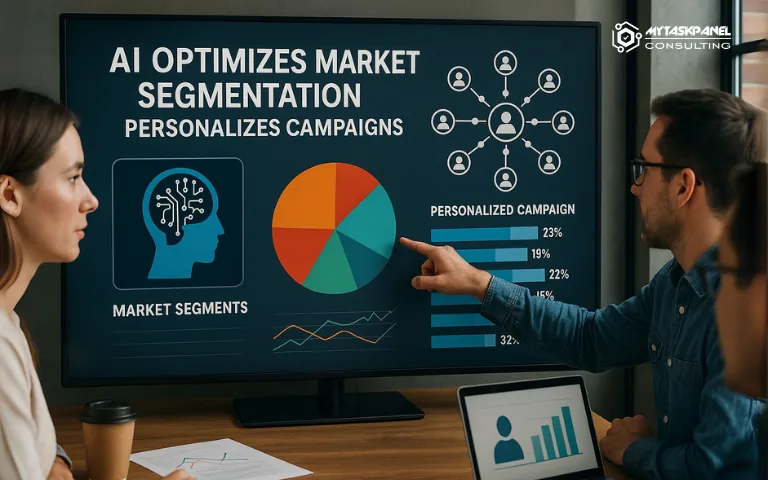One of the fields where AI is having the greatest impact is marketing—specifically in market segmentation and campaign personalization. This technology has revolutionized how brands understand, identify, and communicate with their audiences, taking marketing strategy to an unprecedented level.
Below, we’ll explore what it means to apply AI to market segmentation, its benefits, challenges, concrete examples, and its impact on the personalization of advertising campaigns.
What is AI-based market segmentation?
Traditional market segmentation divides consumers into smaller groups with common characteristics, such as age, location, income, or behavior. However, this approach can be limited when dealing with the dynamic behavior of digital consumers.
This is where AI comes in. By using machine learning algorithms, natural language processing, and predictive analytics, AI can identify complex patterns within large volumes of data. This enables real-time audience segmentation with much greater precision, taking into account hundreds of variables simultaneously, such as:
- Purchase history.
- Social media interactions.
- Browsing time.
- Content preferences.
- Real-time geographic location.
- Emotional state (measured through tone in text or voice).
In this way, AI in market segmentation not only improves accuracy but also enables campaigns to be tailored to current behavior—not just generic demographic data.
Advantages of using AI in market segmentation
1. Greater precision and personalization
AI can uncover hidden patterns in data that human analysis might miss, allowing for extremely detailed segmentation. This leads to personalized campaigns that feel unique to each user, enhancing customer experience and increasing conversion rates.
2. Smart automation
AI enables the automation of segmentation and personalization processes in real time. This reduces the manual workload of marketing teams and accelerates data-driven decision-making.
3. Budget optimization
By targeting the audiences most likely to convert with greater precision, companies can optimize their ad spend and avoid wasting resources on unresponsive segments.
4. Predictive analytics
AI not only analyzes what customers have done, but can also predict what they will do. This allows brands to anticipate customer needs and design proactive, rather than reactive, campaigns.
Challenges and risks of AI in marketing
1. Data quality
Algorithms are only as good as the data that feeds them. Incomplete, biased, or outdated data can lead to erroneous conclusions and ineffective segmentation.
2. Privacy and legal compliance
Using personal data poses serious ethical and legal implications. Companies must ensure compliance with regulations like the GDPR or California Consumer Privacy Act (CCPA).
3. Lack of transparency
Some AI models function as «black boxes» where even developers cannot fully explain how a decision was made. This can complicate result validation and regulatory accountability.
4. Technological dependence
Relying too heavily on automated systems may diminish the strategic capabilities of human teams if not managed properly.
Successful use cases of AI in segmentation and personalization
Netflix and content recommendation
Netflix uses AI to analyze user behavior (watch time, pauses, skips, ratings) and segments users into micro-groups with similar interests. This enables the personalized display of thumbnails, trailers, and recommendations.
Amazon and product recommendations
Amazon’s recommendation engine is one of the most advanced globally. It uses AI to analyze purchase history, search behavior, reviews, and similar users’ behavior to generate hyper-personalized suggestions that increase average cart value.
Spotify and personalized playlists
Spotify employs AI and machine learning algorithms to create playlists like «Discover Weekly» or «Release Radar» based on each user’s musical tastes and listening habits, generating a unique experience for millions of people.
How to implement AI in your marketing strategy
To successfully adopt AI in market segmentation and campaign personalization, consider the following steps:
- Data audit: ensure available data is relevant, up to date, and properly structured.
- Define clear objectives: set goals (increase conversions, lower CAC, improve retention, etc.).
- Choose the right tools: platforms like Salesforce Einstein, Adobe Sensei, IBM Watson, or HubSpot offer integrated AI marketing modules.
- Train and fine-tune models: algorithms must be trained with real data and continuously refined to improve accuracy.
- Monitor and adjust: AI doesn’t replace human judgment. It’s crucial to review key metrics and adjust strategies based on results.
The future of AI in digital marketing
As AI continues to evolve, we’ll see even deeper integration with technologies such as:
- Conversational AI chatbots for personalized customer service and sales.
- Personalized Augmented Reality (AR), where products visually adapt to the user in real time.
- Emotional AI, capable of tailoring ad messages based on the user’s emotional state.
- Predictive conversational marketing, which anticipates customer questions before they’re asked.
These innovations promise to radically transform how brands interact with their audiences.
AI in market segmentation has redefined the rules of the game for marketing professionals. Its ability to analyze complex data, identify patterns, and personalize campaigns in real time represents a unique opportunity to enhance the efficiency and effectiveness of business strategies.
However, like any powerful tool, it must be used responsibly, transparently, and ethically. Companies that successfully integrate AI into their marketing strategies in a balanced way will be better positioned to connect meaningfully with their audiences, foster loyalty, and grow in an increasingly competitive market.

